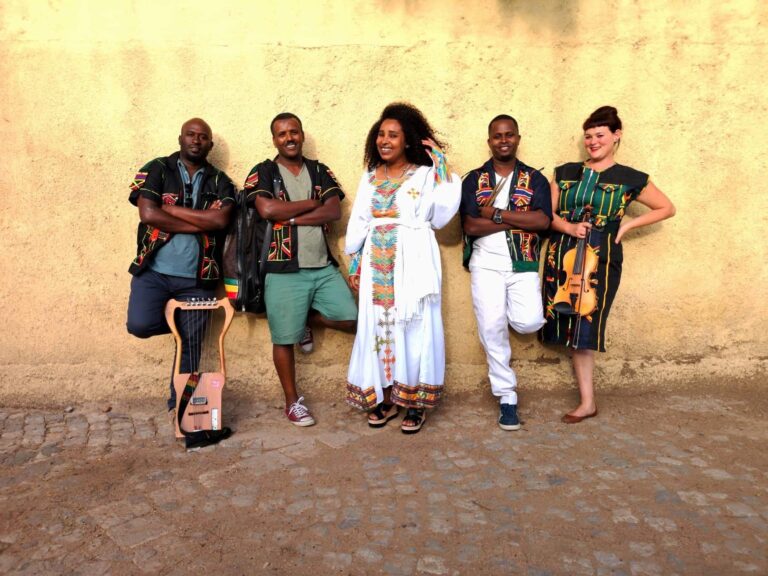The last time Brian Rusk participated in the Whatcom County Farm Tour, he set up a small aquaponics demonstration in the barn at FarmWild to show attendees how produce could be grown without soil, using limited water and integrating nutrients provided by fish waste.
“One of the biggest questions people asked me then was, ‘OK, this produces enough greens to feed your family, but can you scale up?’” Rusk, 48, said during a Friday morning tour of his family’s 27-acre property on Smith Road. “I answered, ‘I don’t know, but I’ll find out.’”
Fast-forward a few years, and the aquaponics greenhouse and associated grow rooms that have since been built at FarmWild enable Rusk and his crew to cultivate as much produce as could be grown on an acre of farmland in a year.
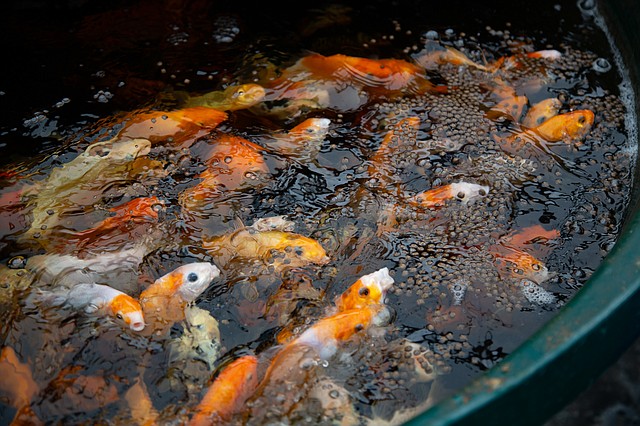 Koi eat fish food in a tank in the greenhouse. Hoses pump the filtered water into the grow beds for the produce. “By feeding the fish, what I basically just did is fertilize the plants,” Brian Rusk said. (Hailey Hoffman/Cascadia Daily News)
Koi eat fish food in a tank in the greenhouse. Hoses pump the filtered water into the grow beds for the produce. “By feeding the fish, what I basically just did is fertilize the plants,” Brian Rusk said. (Hailey Hoffman/Cascadia Daily News)
The space is bursting with basil, bok choy, kale, collard greens, lettuce, cilantro, parsley, ginger, turmeric and other edible offerings, but a key ingredient to the success of the endeavor is in the four tanks full of various sizes of koi fish located on the right side of the greenhouse.
Rusk said the water circulates from the fish tanks to the grow tables via pumps that take the drain water, run it through a filter to get the solid material out, and then direct the water with the dissolved nutrients to the tables. There, floating trays with plant “plugs” deliver nutrients to the roots.
“I grow about 120 pounds of basil every week, year-round,”
Rusk said. “I plant seeds every Wednesday, year-round. And every week I have to harvest just as much as I plant because there’s a six-week cycle everything has to move through. I plant inside (under grow lights), then have a transplanting spot and at the end of the fourth week, move everything out to the greenhouse.”
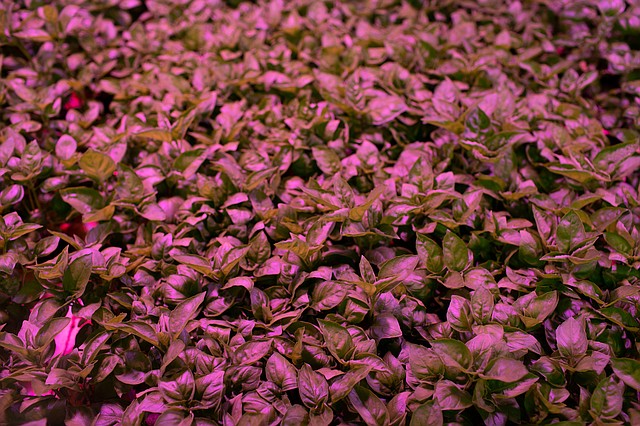 Pink LED grow lights simulate the sun and help basil and other plants grow indoors. The lights are typically only used from October to mid-April. (Hailey Hoffman/Cascadia Daily News)
Pink LED grow lights simulate the sun and help basil and other plants grow indoors. The lights are typically only used from October to mid-April. (Hailey Hoffman/Cascadia Daily News)
When Rusk opens up FarmWild for this year’s Whatcom County Farm Tour — which takes place at 12 area farms Saturday, Sept. 17 as part of Sustainable Connections’ Eat Local Month — visitors will be able to walk through the greenhouse and find out more about how aquaponic farming works, and what it took for the small farm to “scale up” to its current level of production. They’ll also get a primer on how the practice is better for the environment.
“Aquaponics is the epitome of resource-efficient farming,”
Rusk said. “It uses the least amount of nutrients, least amount of water, least amount of land space, and grows the most amount of food in as small a footprint as possible.”
 Surrounded by fresh basil and turmeric plants, Brian Rusk stands in FarmWild’s greenhouse on Aug. 26. Rusk grows fresh produce in the space year-round with his aquaponics set-up. (Hailey Hoffman/Cascadia Daily News)
Surrounded by fresh basil and turmeric plants, Brian Rusk stands in FarmWild’s greenhouse on Aug. 26. Rusk grows fresh produce in the space year-round with his aquaponics set-up. (Hailey Hoffman/Cascadia Daily News)
From the farm to the plate, the ecological footprint Rusk espouses isn’t confined to the greenhouse. When he began farming approximately six years ago after a successful career as a research geologist, it was with a mission to grow food in ways that were sustainable and better for the environment.
To that end, solar panel arrays on the house and barn help provide electricity throughout the farm. An electric vehicle delivers fresh produce and eggs to area restaurants — some of which will be participating in Eat Local Month and Restaurant Week (Sept. 1–8) by providing specials using FarmWild’s garden goods. Additionally, the manure from the hundreds of chickens who free-range on up to 10 acres of land feeds the soil beneath them. And although the farm isn’t certified organic, everything from the chicken feed to the plant seeds is organic.
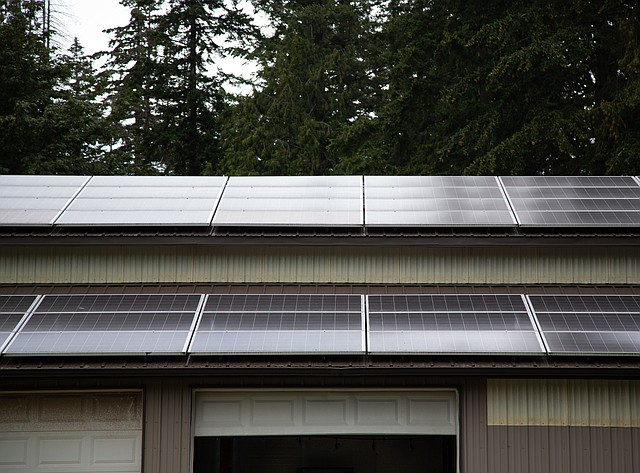 An array of solar panels draw energy to fuel the grow lights on the inside of the barn and in the aquaponics greenhouse. (Hailey Hoffman/Cascadia Daily News)
An array of solar panels draw energy to fuel the grow lights on the inside of the barn and in the aquaponics greenhouse. (Hailey Hoffman/Cascadia Daily News)
From the egg-laying chickens and those grown for meat in large mobile coops, to the four alpacas who have plenty of room to graze, the small herd of sheep who were recently introduced to the farm and are currently hanging out in a wooded part of the acreage, and the koi who are released into an on-site pond when they get too big for the tanks, every animal at FarmWild is given its best life.
Rusk wouldn’t have it any other way, and he’s quick to point out that industrial, large-scale farming is often done at the expense of both the animals and the land. Instead of cramming as many chickens as possible in the barn and raising them in cages where they lay their eggs on conveyer belts and never go outside, he’s carrying grains to his chickens, worrying about predators and moving their mobile coops on a regular basis. They even get fed overflow produce from the greenhouse.
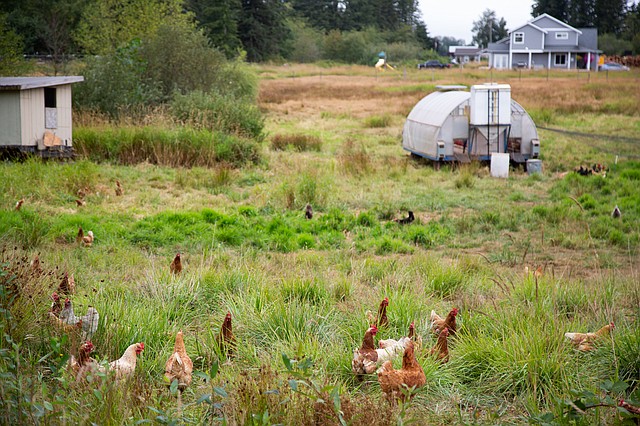 Hundreds of chickens roam in the pasture at FarmWild. Three chicken coops on trailers are moved every few weeks to allow manure from the coops to help feed the plants and grass. (Hailey Hoffman/Cascadia Daily News)
Hundreds of chickens roam in the pasture at FarmWild. Three chicken coops on trailers are moved every few weeks to allow manure from the coops to help feed the plants and grass. (Hailey Hoffman/Cascadia Daily News)
“People think farmers must be getting rich at farmers markets because they’re charging $8 for a dozen eggs or $4 for a head of lettuce,”
Rusk said, “but the truth is it’s so much extra work to do it in this way — where the animals and the ecology have a good life and you’re feeding the ecosystem. It costs a lot more and takes a lot more labor and effort. It goes into the price of the product you’re creating.”
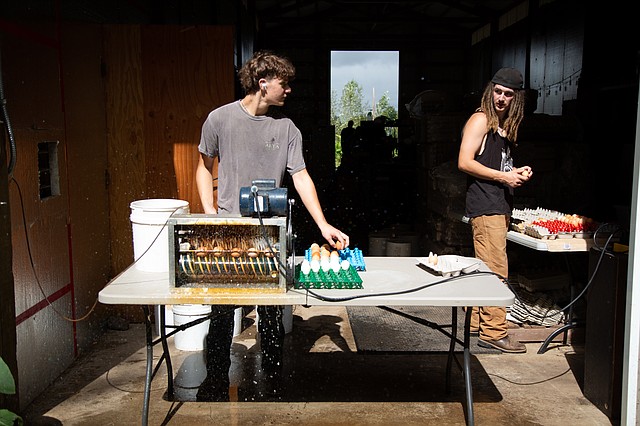 Caden, left, and Connor Mosher wash eggs. During the summer, the free-range chickens at FarmWild lay as many as 120 dozen eggs a week. (Hailey Hoffman/Cascadia Daily News)
Caden, left, and Connor Mosher wash eggs. During the summer, the free-range chickens at FarmWild lay as many as 120 dozen eggs a week. (Hailey Hoffman/Cascadia Daily News)
But in the years Rusk has spent experimenting with aquaponics, raising chickens for eggs and meat, growing other smaller crops to share with family and friends, and figuring out how to shrink the farm’s ecological footprint, he’s come to realize the work is its own reward.
“It’s what drives me,” he said. “It’s worth it for me, mentally, for sure.”
To find out more about how to procure produce and eggs from FarmWild, go to farmwild.love.
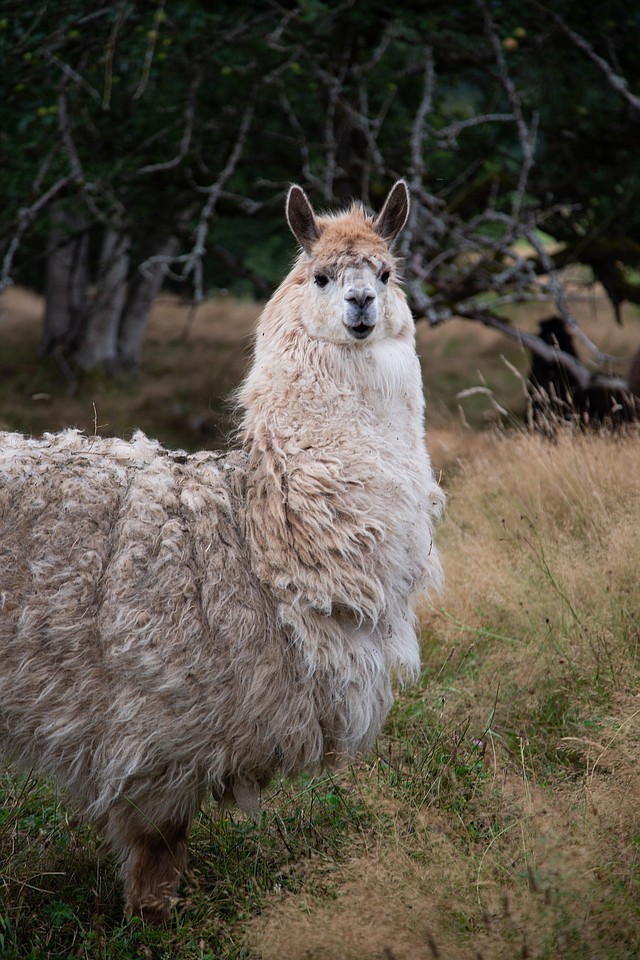 Several alpacas roam around a pasture in the back of FarmWild. (Hailey Hoffman/Cascadia Daily News)
Several alpacas roam around a pasture in the back of FarmWild. (Hailey Hoffman/Cascadia Daily News)
A Guide to Eat Local Month
What: Eat Local Month
When: Sept. 1–30
Where: Throughout Whatcom County
More: Sustainable Connections hosts this annual month-long celebration of local food and those who grow, raise, harvest and prepare it to share with the community. Pick up a newly updated Northwest Washington Food & Farm Finder to discover local food, farms, restaurants, markets and products in Whatcom, Skagit, San Juan and Island counties.
Highlights
Sept. 2–8, celebrate Restaurant Week. More than 17 local restaurants will debut menu specials comprised of 50% or more local ingredients. The specials will run throughout September.
Sept. 9–17 is Farm Week. Learn about local agriculture and enjoy activities like the Whatcom County Farm Tour, which takes place from 10 a.m. to 4 p.m. Saturday, Sept. 17. Each of the 12 locations will offer an opportunity to meet people who grow and raise food and learn more about how that food makes it from the farm to the plate.
Sept. 17–22 brings Seafood Week. Before or after attending the farm tour, head to Squalicum Harbor for SeaFeast on Sept. 17, which kicks off the week of seafood-focused events.
Sept. 23–30 is Market Week. Farmers markets throughout the area are still going strong, so pick up bountiful produce, crafts and other goods this week.
For more details, go to sustainableconnections.org/eat-local-month.




